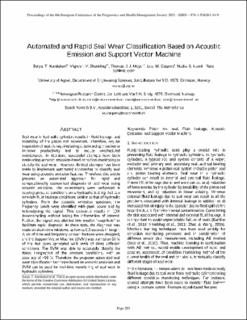| dc.contributor.author | Kandukuri, Surya Teja | |
| dc.contributor.author | Shanbhag, Vignesh Vishnudas | |
| dc.contributor.author | Meyer, Thomas | |
| dc.contributor.author | Caspers, Leo | |
| dc.contributor.author | Noori, Nadia | |
| dc.contributor.author | Schlanbusch, Rune | |
| dc.date.accessioned | 2021-09-08T10:35:35Z | |
| dc.date.available | 2021-09-08T10:35:35Z | |
| dc.date.created | 2021-06-30T12:08:19Z | |
| dc.date.issued | 2021 | |
| dc.identifier.citation | Proceedings of the European Conference of the Prognostics and Health Management Society (PHME). 2021, 6 (1), 203-210. | en_US |
| dc.identifier.issn | 2325-016X | |
| dc.identifier.uri | https://hdl.handle.net/11250/2774591 | |
| dc.description.abstract | Seal wear in hydraulic cylinders results in fluid leakage, and instability of the piston rod movement. Therefore, regular inspection of seals is required using automated approaches to improve productivity and to reduce unscheduled maintenance. In literature, successful attempts have been made using acoustic emission-based condition monitoring to classify the seal wear. However, limited attempts have been made to implement automated approaches to classify seal wear using acoustic emission features. Therefore, this article presents an automated approach for rapid and computationally economical diagnosis of seal wear using acoustic emission. The experiments were performed at varying pressure conditions on a hydraulic test rig that can simulate fluid leakage conditions similar to that of hydraulic cylinders. From the acoustic emission spectrum, the frequency bands were identified with peak power and by heterodyning the signal. This technique results in 10X downsampling without losing the information of interest. Further, the signal was divided into smaller “snapshots” to facilitate rapid diagnosis. In these tests, the diagnosis was made on short-time windows, as low as 0.3 seconds in length. A set of time and frequency domain features were designed, and the Support Vector Machine (SVM) was trained on 60 % of the test cases generated with seals of three different conditions. The SVM was able to accurately classify the status irrespective of the pressure conditions, with an accuracy of ~99 %. Therefore, the proposed automated seal wear classification technique based on acoustic emission and SVM can be used for real-time monitoring of seal wear in hydraulic cylinders. | en_US |
| dc.language.iso | eng | en_US |
| dc.rights | Attribution 3.0 Unported (CC BY 3.0) | * |
| dc.rights.uri | https://creativecommons.org/licenses/by/3.0/ | * |
| dc.title | Automated and Rapid Seal Wear Classification Based on Acoustic Emission and Support Vector Machine | en_US |
| dc.type | Journal article | en_US |
| dc.type | Peer reviewed | en_US |
| dc.rights.holder | | |
| dc.description.version | publishedVersion | en_US |
| cristin.ispublished | true | |
| cristin.fulltext | original | |
| cristin.fulltext | original | |
| cristin.qualitycode | 1 | |
| dc.identifier.doi | https://doi.org/10.36001/phme.2021.v6i1.2942 | |
| dc.identifier.cristin | 1919544 | |
| dc.source.journal | Proceedings of the European Conference of the Prognostics and Health Management Society (PHME) | en_US |
| dc.source.volume | 6 | en_US |
| dc.source.issue | 1 | en_US |
| dc.source.pagenumber | 203-210 | en_US |
| dc.relation.project | Norges forskningsråd: 237896 | en_US |

